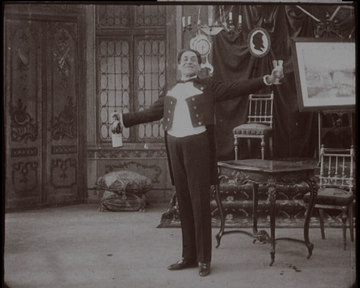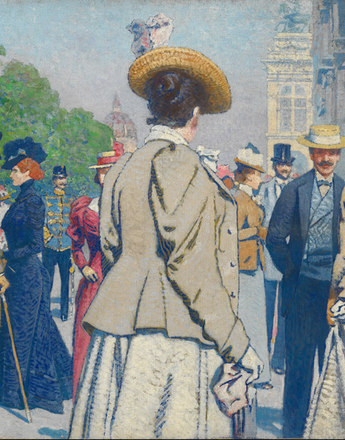Roll up! Performances, attractions, shows and sound experiences
The early cinema was closer to vaudeville than theatre. Variety was the driving force in the pioneer days, and films were presented with much fanfare at festivals and fairs, where the cinematographic shows were to be mainly found.
Films were often part of a revue that might include ‘physical abnormalities’, wax figures, machines, Kaiserpanoramas and sketches, artistic presentations or song and dance numbers. Moreover, cinema in the silent film era was never ‘silent’ but accompanied by a tumult of noises, voices and sounds. The musical accompaniment set the mood and often lent the films a distinctive atmosphere. The simulation of various sounds by means of machines or instruments, saucepans, metal sheets or whips made the film narratives more realistic.
The story was not always readily understandable in these early days, and there was a need for additional explanation. Film programmes, which were also a major component of a visit to the cinema in Austria-Hungary in 1910, were used less to draw in the public than to explain the film plot. A special role was played by film narrators, who explained the action on screen to the untrained audiences. They pointed out what was going on, invented their own dialogue and interpreted the action with moralistic commentaries or historical and scientific information. They were often quite skilful at adapting the content to the local situation and the tastes and interests of their audiences. As the decade progressed, the introduction of title cards and the gradual development of films in which the plot could be more easily followed made the accompanying spoken word less important.
To maintain interest in the films, the producers used special effects (colouring, close-ups, montage) and technical improvements. Attempts were made, for example, to offer synchronous audio and video recordings of dialogue or songs. Equipment was produced from 1903 for the presentation of ‘sound’ film documents. Thanks to the complex linking of the film projector and gramophone, the audio pictures of a three-minute song, for example, were surprisingly realistic. The invention of ‘speaking, singing and musical photography’ meant that the performances by the popular actor Alexander Girardi (1850–1918) have been preserved for posterity. The audio film of ‘Rauschlied’ from Edmund Eysler’s operetta Künstlerblut was a technical sensation for Girardi’s contemporaries.
Translation: Nick Somers
Châteauvert, Jean: Das Kino im Stimmbruch, in: KINtop5, „Aufführungsgeschichten“, Jahrbuch zu Erforschung des frühen Films, Basel/Frankfurt am Main 1996, 81-93
Warstat, Dieter Helmuth: Frühes Kino der Kleinstadt, Berlin 1982
-
Chapters
- Projection shows – precursors of the cinema
- The first cinematograph in Vienna – a medium takes Austria-Hungary by storm
- From travelling show to cinema
- Roll up! Performances, attractions, shows and sound experiences
- ‘Numbers’ – jewels from all over the world
- From ‘view’ to narration: genres and stars
- Austrian film pioneers



